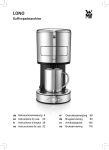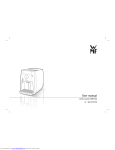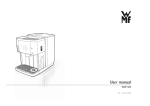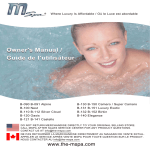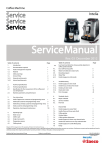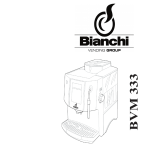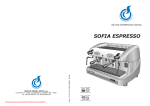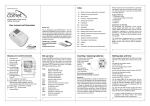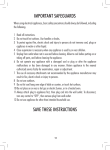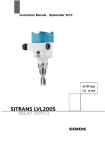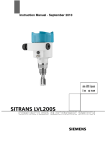Download 1 Operator control panel
Transcript
Legend for overview pictorial on the flip-open side
1 Locking button
6 Drip tray with drip tray grid
2 Door
7 Beverage dispenser with 4 spouts:
3 Water tank
7a Hot water spout
4 Mains cable
7b Milk foaming steam nozzle
5 WMF milk connector
7c 2 coffee spouts
5a Milk hose
8 Pad cassette
Beverage buttons with
5b Handle
9
illuminated cross
5c Milk hose adapter
10 Function keys
Operator control panel
The descriptions in this user manual are
always based on the assumption that
coffee pad machine is ready to operate.
1
An overview of the functions and indications
The following functions are what makes
your WMF 10 coffee pad machine unique:
Beverage buttons with illuminated cross
You can select a coffee speciality by
pressing a button.
The signals of the illuminated cross simplify
the operation.
The following signals are displayed:
Illuminated cross
(in the beverage
buttons field)
Double cup function
There is double cup function to
simultaneously give two portions of coffee
for the perfect coffee for two.
Milk system
With the WMF milk connector, preparing
cappuccino and latte macchiato are
simplicity itself. WMF easy clean makes
regular cleaning simple.
Tank must be filled
flashes red
Device being heated
flashes red slowly
energy-saving sleep mode
glows white
Brewing stand-by for all coffee
beverages and hot water
pulses white
Dispensing going on
flashes white
Teach-In mode active
series of white flashes Programming of water hardness
flashes white 3x
Reporting success - Teach-In,
programming of water hardness
glows white
Double cup function is activated
flashes red
Descaling program is running
Double cup button
Descaling button
Teach-In
You can individually set the volumes of your
cups.
Energy saving functions
The sleep mode as well as the automatic
switch off help to save energy.
flashes red
Cleaning button
flashes red
Appliance must be descaled soon
flashes red
Descaling urgently required
glows blue
flashes blue
rapidly flashes blue
Rinsing or cleaning ongoing
no more beverage removal is possible
Rinsing at the time of initial setup/
prompt for rinsing after descaling
Prompt for cleaning - 1 minute long
GB
Preliminary comments
Congratulations on choosing your new coffee pad machine WMF 10.
Coffee, latte macchiato or cappuccino - with the WMF 10, you can get your favourite hot drink by just pressing a button.
Before starting
Read this user manual before you start preparing the coffee. Only then you can use all the functions, operate your WMF 10 safely
and treat yourself to a wonderful cup of coffee .
Signs and symbols
Next to the text, you will find the following symbols with the following meaning.
Symbols for hazard instructions in Chapters 2 to 6
Hazard!
Hazard of being injured!
Hazard!
Risk of burns and scalding!
Hazard!
Potentially lethal hazard due to electric
shock!
Caution!
Risk of possible material damage!
Symbols for tips and cross references
Useful information and tips
Cross reference
Table of contents
1
For your safety . . . . . . . . . . . . . . . . . . . . . . . . . . . . . . . . 1
1.1
1.2
Intended use . . . . . . . . . . . . . . . . . . . . . . . . . . . . . . . . . . . . . . . . . . . . . . 1
Hazard instructions . . . . . . . . . . . . . . . . . . . . . . . . . . . . . . . . . . . . . . . . . 2
2
Initial setup . . . . . . . . . . . . . . . . . . . . . . . . . . . . . . . . . . 5
2.1
2.2
2.3
2.4
Supplied kit and optional accessories . . . . . . . . . . . . . . . . . . . . . . . . . . 5
Installation and connection . . . . . . . . . . . . . . . . . . . . . . . . . . . . . . . . . . 6
Fill the water tank and insert the water filter . . . . . . . . . . . . . . . . . . . 7
Rinsing for first time of use. . . . . . . . . . . . . . . . . . . . . . . . . . . . . . . . . . 9
3
Operation . . . . . . . . . . . . . . . . . . . . . . . . . . . . . . . . . . . 11
3.1
3.2
3.3
3.3.1
3.3.2
3.3.3
3.3.4
3.4
3.5
3.6
Switching on and off, cancelling preparation . . . . . . . . . . . . . . . . . . 11
Preparing the WMF milk connector . . . . . . . . . . . . . . . . . . . . . . . . . . 12
Coffee preparation . . . . . . . . . . . . . . . . . . . . . . . . . . . . . . . . . . . . . . . . 13
Inserting the coffee pads . . . . . . . . . . . . . . . . . . . . . . . . . . . . . . . . . . . 14
Inserting the ground coffee cassette . . . . . . . . . . . . . . . . . . . . . . . . . 16
Preparing a small and a large coffee. . . . . . . . . . . . . . . . . . . . . . . . . . 17
Preparing cappuccino and latte macchiato . . . . . . . . . . . . . . . . . . . . 19
Milk foam . . . . . . . . . . . . . . . . . . . . . . . . . . . . . . . . . . . . . . . . . . . . . . . 21
Hot water . . . . . . . . . . . . . . . . . . . . . . . . . . . . . . . . . . . . . . . . . . . . . . . 22
Resetting the cup volumes to default values. . . . . . . . . . . . . . . . . . . 22
4
Energy saving functions . . . . . . . . . . . . . . . . . . . . . . . . 23
4.1
4.2
Sleep mode. . . . . . . . . . . . . . . . . . . . . . . . . . . . . . . . . . . . . . . . . . . . . . . 23
Automatic switch-off . . . . . . . . . . . . . . . . . . . . . . . . . . . . . . . . . . . . . . 23
5
Caring for the coffee pad machine. . . . . . . . . . . . . . . . 24
5.1
Care overview . . . . . . . . . . . . . . . . . . . . . . . . . . . . . . . . . . . . . . . . . . . . 24
5.2
5.2.1
5.2.2
5.3
5.4
5.4.1
5.4.2
5.4.3
5.4.4
5.5
5.5.1
5.5.2
5.5.3
5.5.4
Clean the milk foamer . . . . . . . . . . . . . . . . . . . . . . . . . . . . . . . . . . . . . 25
Express cleaning of the WMF easy clean . . . . . . . . . . . . . . . . . . . . . . 25
Cleaning prompt . . . . . . . . . . . . . . . . . . . . . . . . . . . . . . . . . . . . . . . . . . 25
Rinsing . . . . . . . . . . . . . . . . . . . . . . . . . . . . . . . . . . . . . . . . . . . . . . . . . . 26
Manual cleaning . . . . . . . . . . . . . . . . . . . . . . . . . . . . . . . . . . . . . . . . . . 27
Milk foamer . . . . . . . . . . . . . . . . . . . . . . . . . . . . . . . . . . . . . . . . . . . . . . 29
Coffee spout cassette with sieve insert . . . . . . . . . . . . . . . . . . . . . . . 31
Pad cassette and ground coffee cassette . . . . . . . . . . . . . . . . . . . . . . 32
Steam nozzle . . . . . . . . . . . . . . . . . . . . . . . . . . . . . . . . . . . . . . . . . . . . . 32
Descaling . . . . . . . . . . . . . . . . . . . . . . . . . . . . . . . . . . . . . . . . . . . . . . . . 33
Scaling display . . . . . . . . . . . . . . . . . . . . . . . . . . . . . . . . . . . . . . . . . . . . 33
Setting the water hardness . . . . . . . . . . . . . . . . . . . . . . . . . . . . . . . . . 34
Descaling agent . . . . . . . . . . . . . . . . . . . . . . . . . . . . . . . . . . . . . . . . . . . 35
Applying the descaling program . . . . . . . . . . . . . . . . . . . . . . . . . . . . . 36
6
Measures for problem rectification . . . . . . . . . . . . . . . 39
7
Transportation and disposal . . . . . . . . . . . . . . . . . . . . . 45
8
Technical data . . . . . . . . . . . . . . . . . . . . . . . . . . . . . . . 46
9
Warranty and Service, Index . . . . . . . . . . . . . . . . . . . . 47
9.1
9.2
Warranty and Service . . . . . . . . . . . . . . . . . . . . . . . . . . . . . . . . . . . . . . 47
Index . . . . . . . . . . . . . . . . . . . . . . . . . . . . . . . . . . . . . . . . . . . . . . . . . . . . 47
GB
For your safety
1
For your safety
Maximum possible safety of devices is one of the characteristics of WMF products to which we give our
special attention. The integrated safety devices of WMF 10 are however only effective if you follow the
following safety instructions.
1.1
Intended use
The WMF 10 is a coffee pad machine for coffee, cappuccino and latte macchiato.
The WMF 10 is designed exclusively for preparing coffee and coffee-milk beverages as well as milk foam
and hot water. Only coffee softpads with an external diameter of 7 cm can be used.
The WMF 10 is designed for preparing quantities normal in private use and is unsuitable for commercial
purposes. The WMF 10 is not intended for use in areas such as kitchens for employees, in shops, offices
and other commercial areas, in agriculture, or for use by customers in hotels, motels, bed-and-breakfast
hotels and other residential facilities.
This appliance is not intended for use by persons (including children) with limited physical, sensory
or mental abilities or those with a lack of experience and/or knowledge, unless they are supervised
by a person responsible for their safety or have received from such a person instructions on how the
appliance is to be used.
Do not operate the appliance if it is not supervised. The appliance may not be used at altitudes greater
than 1500 m above sea level. In case of misuse, incorrect connection, incorrect operation, improper
repair or non-compliance with the above mentioned specifications, no liability will be accepted for any
damage. No liability whatsoever is accepted for damage caused by neglecting cleaning or descaling or by
using other cleaning products or scaling products than those of WMF. All warranty and guarantee claims
will be rendered null and void.
1
For your safety
1.2
Hazard instructions
Despite all safety precautions, there is a hazard potential associated with each device due to improper
handling. Therefore, follow the given instructions while using your coffee pad machine to avoid injuries
and health hazards.
GB
Possible risk to life due to electric shock!
Water or other fluids that have seeped into the electronic components of your coffee pad machine can
lead to potentially lethal electric shocks.
> Do not clean your coffee machine under running water, with steam cleaners or with steam jets.
> Never open the housing of your coffee pad machine.
> Never reach into the interior of your coffee pad machine, do not use any tools etc.
Possible danger to life due to defects in the appliance!
If the coffee pad machine or the mains cable is damaged, or if there is a doubt about a defect after it has
fallen or after any other mishap, electrical shocks are possible.
> Do not use the appliance under any circumstances, do not activate it.
> Switch off the electric supply and pull out the mains cable.
> Do not connect a damaged mains cable and do not repair it yourself.
> Entrust only qualified technical personnel such as WMF After-sales Service with repairing the
appliance or replacing the mains cable.
2
For your safety
Probable risk of burns or scalding due to hot components or steam and hot liquids!
The spouts in the coffee dispenser become very hot during operation. You can get burnt if you touch the
spouts. You can get scalded by hot beverages and steam that is discharged.
> Do not touch the spouts or surfaces directly in its vicinity.
> Avoid contact with the escaping steam or liquids.
> Handle hot beverages with care.
> Allow the machine to cool down before cleaning. Follow the same procedure when you remove or
attach components or accessories.
Possible health hazard!
Neglecting to clean the milk unit, the water tank or using onsumables or materials other than coffee can
affect your health.
> Clean the machine regularly in accordance with the instructions in Chapter
““5 Caring for the coffee pad machine.” on page 24 ff.
> Fill the water tank only with clean, cold drinking water.
> Only use fresh milk or UHT milk for the milk hose.
> Insert only coffee softpads or the ground coffee cassette in the pad cassette.
Possible material damage to sensitive surfaces.
Due to escaping hot steam or water, delicate surfaces and furniture can get damaged.
> Do not operate the appliance under sensitive furniture.
> Protect the delicate surfaces with a base that is water-proof and heat resistant.
> Ensure that the surface remains dry.
3
For your safety
Possible material damage due to overflowing drip tray!
If you only infrequently drain the drip tray, it can overflow. It can possibly damage the delicate items in
the surrounding area.
> Drain the drip tray regularly and rinse after each use.
> Ensure that the machine is switched off in your absence.
GB
Possible damage to the coffee pad machine
The coffee pad machine is sensitive to frost after initial filling with water and can be damaged by frost.
The housing can be melted by open flames or hot plates.
> Operate and store the coffee pad machine only in frost-free rooms.
> Do not place the appliance on hot surfaces or in the vicinity of flames.
4
Initial setup
2
Initial setup
Now you are only few steps away from preparing and enjoying the perfect coffee.
In this chapter, you can learn step-by-step how you can start operating your WMF 10.
2.1
Supplied kit and optional accessories
> Check the scope of supply for completeness.
For effective cleaning of your WMF 10, you can additionally purchase the WMF 1 descaler and the WMF
milk system cleaner from the specialist dealer or from the WMF store.
1
7
6
2
5
4
8
3
5
9
Legend
Scope of supply:
WMF 10 coffee pad
1
machine with mains cable
WMF milk connector:
2 Milk hose with handle
and milk hose adapter
3 Ground coffee cassette
4
Filter paper
5
User manual
6
Water filter
7
Suction cap
Optional accessories:
8
WMF 1 descaler
9
WMF Milk system cleaner
Initial setup
2.2
Installation and connection
> Unpack the coffee pad machine.
GB
Hazard!
Risk of accidents for children at low installation height!
If the height of installation is too low, children can reach into the device and may be injured by hot steam or
water.
> Install the device at least 85 cm, if necessary, even higher, above the floor surface.
> Install the device on a surface with a width of at least 60cm.
> Push the device far to the rear so that the drip tray and the device are out of the reach of children.
Possible material damage to sensitive surfaces!
Due to the escaping hot steam or water, delicate installation surfaces can be damaged.
> Protect the delicate installation surfaces with a base that is water-proof and heat resistant.
> Ensure that the surface remains dry.
> Place the coffee pad machine on a stable, horizontal base that is water-proof and heat-resistant. Keep the
>
>
>
>
machine away from heat sources (hotplate, gas flame etc.).
Place the drip tray grid in the drip tray. Note the position marking on the front right.
Insert the drip tray with the drip tray grid in the coffee pad machine.
Insert the plug of the mains cable in an electrical safety socket.
Protect the mains cable from damage:
- Do not clamp the mains cable.
- Protect the mains cable from sharp edges, moisture, heat or oil.
6
Initial setup
2.3
Fill the water tank and insert the water filter
> To switch on the coffee pad machine, press the On-/Off-/C button.
As long as the water tank is empty, the illuminated cross flashes red.
Caution!
Possible damage to your coffee pad machine with unsuitable liquids!
Liquids other than drinking water can damage your coffee pad machine or result in clogging.
> Fill the water tank of your coffee pad machine only with clean, cold drinking water.
> Never fill the water tank with hot water, mineral water or milk.
Removing the water
tank
7
>
>
>
>
>
Open the door to the water tank.
Tilt the water tank outwards until it snaps into the draining position.
Then lift the water tank outwards.
Remove the cover and take out the accessories in the tank.
Rinse the water tank thoroughly with tap water.
Initial setup
Inserting the water
filter
1
Changeable display
setting
2
Suction cap - fitting
4
3
Depending on the quality of your tap water, you should insert the water filter from the scope of supply
here (see “2.1 Supplied kit and optional accessories” on page 5).
The water filter ensures a genuine coffee taste. It filters out chlorine and other impurities from the water.
> First rinse the water filter under water.
> Insert the water filter (1) in the locating ring on the floor of the water tank without pressing it in.
As time goes on, the quality of the water filter deteriorates. With a daily average consumption of 8 cups
of coffee, the water filter should be changed not later than after every 2 months (approx. 500 cups).
> Set the changeable display (2) on the tank cover to the time of the next water filter replacement.
Water filters are available from the specialist dealers
Even if you do not use a water filter, the suction cap must be correctly assembled, otherwise the tank
cannot be completely emptied during drink preparation and the last cup is not filled completely.
> Take the suction cap (3) and fix it firmly on the locating ring on the floor of the water tank.
> When doing so, ensure that the arrow marking on the suction cap points towards the floating capsule
(4).
8
GB
Initial setup
5
^6
6
Filling the water tank
Inserting the water
tank
6
> Place the tank lid on the water tank.
> Pour cold tap water through the filling opening up to the maximum marking (5).
When using the water tank, the tilting device (6) must be tilted forward.
> Tip the tilting device (6) forward if required.
> Insert the water tank into the appliance and close the door.
The cleaning button flashes blue to prompt you about rinsing.
2.4
Rinsing for first time of use.
> Ensure that the empty pad cassette is pushed in.
> Turn the locking knob to position z.
> Place a collecting vessel with a volume of at least 0.5 litres centrally under all spouts.
9
Initial setup
> Press the cleaning button.
In the beginning, the pump is somewhat louder than usual. During rinsing, the number of rinsing
procedures required is determined electronically. If several rinsing procedures are necessary, they are
interrupted every 45 seconds. The cleaning button flashes blue again.
GB
> If required, empty the collecting vessel and fill up the tank and press the cleaning button again.
As soon as adequate rinsing has been carried out, steam is generated. The illuminated cross then glows
red. The water is heated.
> Turn the locking knob to position |.
10
Operation
3
Operation
In this chapter, you can learn everything about the easy method of coffee preparation with the WMF 10
and how you can individually customise your WMF 10 - entirely according to your preference!
Before the first operation, you should have carried out the initial setup (see Chapter
„2 Initial setup“ on page 5 ff).
Hazard!
Possible risk of burns or scalding due to hot components or steam and hot liquids.
The spouts become very hot during operation and can cause burns if touched. Hot beverages and escaping
steam can scald you.
> Do not touch the beverage dispenser with spouts.
> Avoid contact with the escaping steam and handle the hot beverage with care.
3.1
Switching on and off, cancelling preparation
With the On-/Off-/C-button, you can switch the coffee pad machine on or off or cancel the preparation
of a beverage.
> To switch on the coffee pad machine, press the On-/Off-/C button.
The illuminated cross
- flashes red when the water tank has to be filled,
- glows red while the appliance is heating up,
- glows white as soon as the appliance is ready for operation.
11
Operation
> To switch off the coffee pad machine, press the On-/Off-/C button again until the displays go off.
> If you wish to prematurely cancel a beverage preparation process, press the On/Off/C button.
GB
Remember, when switching off the appliance or cancelling a process: The dispensing of the beverage
does not stop immediately. A small quantity continues to flow after switching off. Leave the cup in
position for that time.
3.2
Preparing the WMF milk connector
To make milk foam for cappucino, latte macchiato or milk beverages, you have to insert the milk hose of
the WMF milk connector in a vessel with milk.
Milk is a very sensitive foodstuff. Always ensure cleanliness when using milk. Always keep the milk in a
cooler.
12
Operation
>
>
>
>
Fill a milk container with cooled milk up to a maximum of height of 15 cm.
Place the milk container on the right next to the appliance.
Insert the WMF milk connector until it comes to rest in the opening on the right-hand side.
Submerge the end of the milk hose in the milk.
The end of the milk hose should reach down to the bottom of the milk container, so that no air is sucked in.
3.3
Coffee preparation
> Fill fresh tap water every day into the water tank.
You can very easily get your favourite coffee beverage by using commercial coffee pads. How to insert
the coffee pads in the pad cassette is explained in Chapter 3.3.1 on page 14 ff. You can also enjoy freshly
ground coffee. To do so, instead of the coffee pads, use the ground coffee cassette as described in
Chapter 3.3.2 on page 16 ff.
Caution!
Functional fault owing to blockage of the pad cassette.
Damaged pads, loose coffee powder or instant coffee can block the pad cassette. The locking knob gets
blocked and the pad cassette cannot be removed any more.
> Only insert suitable coffee pads or the ground coffee cassette in the pad cassette.
> Never insert damaged pads, loose coffee powder or instant coffee in the pad cassette.
> Check each time before brewing coffee, whether
- the opening in the middle of the pad cassette is free,
- the pads are undamaged and
- the pad cassette is free of ground coffee residue.
13
Operation
3.3.1
Inserting the coffee pads
Use only commercial coffee pads with 7 cm outer diameter (coffee quantity approx. 7 g). Coffee pads
with a smaller diameter do not make good coffee. Hard pads that are offered for the espresso machines
and pads with additives for cappuccino or the like cannot be used.
1
2
> Turn the locking knob (1) up to position Y| and immediately back to the
home position |.
As a result, the pad cassette (2) is pushed out of the shaft to facilitate removal.
The pad cassette can be used from two sides. The side marked with c is envisaged for one coffee pad
and the one marked with d for two coffee pads.
The quantity of coffee powder in a pad is optimally adjusted to one cup at 125 ml. You can thus vary the
cup volumes per cup according to your wishes and change the strength of the coffee.
Carefully close the pad storage packaging to avoid aroma losses.
14
GB
Operation
The more carefully you insert the coffee pads, the better your coffee will be. Therefore, follow the
instructions below:
1 Inserting the coffee
pad
> Distribute the powder uniformly in the coffee pad up to the edge so that water cannot get past the
coffee pad.
> Lay the coffee pad flat in the recess of side c
Inserting 2 coffee pads
15
>
>
>
>
Rotate the pad cassette to side d.
Press the first coffee pad in the lower recess so that the paper border of the coffee pad is on top.
Put the second coffee pad flat on it.
Ensure that the edge of the upper coffee pad is flat in the recess of the pad cassette and does not
project out or is folded inwards.
Operation
Pad cassette
sliding in
> When pushing in the pad cassette, ensure that the pad does not get displaced. Otherwise the seal
does not close reliably.
> Turn the locking knob in position z as much as possible to the right, to firmly clamp the pads in the
brewing system.
3.3.2
Inserting the ground coffee cassette
The ground coffee cassette is available for freshly ground coffee.
1
2
> Turn the locking knob (1) up to position Y| and immediately back to the
home position |.
As a result, the pad cassette (2) is pushed out of the shaft a little for easier removal. The side of the pad
cassette marked with a d is also intended for the ground coffee cassette.
> Rotate the pad cassette to side d.
> Insert a sheet of filter paper in the ground coffee cassette.
It retains suspended particles, which enhances the flavour of the coffee.
16
GB
Operation
However, you can also work without filter paper. If you need spare filter paper, you can get it from a
specialist dealer or directly from WMF after-sales service.
> Fill the coffee or espresso powder. The ground coffee cassette can contain 6 to 7.5 g of coffee,
depending on the quality of the coffee, sufficient for one cup of coffee.
> Wipe off the ground coffee cassette up to the edge, and press down the powder just a little.
> Press on the cover.
> Thoroughly remove powder residues sticking to the outside.
Powder residues can block the pad cassette and the locking knob.
> Insert the ground coffee cassette on side d of the pad cassette.
Pad cassette
sliding in
> Push the prepared pad cassette into the shaft and rotate the locking knob into position z as much
as possible to the right.
3.3.3
Preparing a small and a large coffee
You can choose between a small or a large coffee.
You then have additional selection options between
- one cup
- two cups simultaneously ("double cup function")
- an individually chosen cup size ("Teach-in programming")
If you wish to prepare a small coffee, you should first pre-warm the cup. To do so, you can let some hot
water, as described in Chapter 3.5 on page 22, flow into the cup that has already been put in place.
17
Operation
One cup
> Place a cup centrally below the two coffee spouts.
> Wait until the illuminated cross glows white.
> Press the button for large coffee or small coffee.
GB
The corresponding quantity is filled into the cup.
Double cup function
Place the two cups close to one another below the two coffee spouts.
> Wait until the illuminated cross glows white.
> Press the double cup button .
It glows for 5 seconds
> During that time, press the button for a large or small coffee.
The corresponding quantity is filled into the cups.
Teach-Inprogramming
With the Teach-In function, you can change the cup volumes according to your personal wishes. Up to
approx. 120 ml cup volume for the small coffee or up to approx. 165 ml for the large coffee can be set.
Coffee quantities below 50 ml do not give a satisfactory result.
> Place a cup of any size centrally below the two coffee spouts.
> Wait until the illuminated cross glows white.
> Keep the button of that beverage pressed, for which you wish to change the cup volume
(large or small coffee).
The illuminated cross pulses white to start with, because the brewing process is starting. After 3
seconds, the illuminated cross flashes white to indicate that the Teach-In mode has been activated.
> Release the cup and keep an eye on the filling level.
> Press the button as soon as the desired quantity has been reached.
The illuminated cross flashes white 3 times to confirm successful programming.
18
Operation
If you wish to set the cup volume to the maximum value, do not press the button again. The coffee
dispensing stops automatically at the maximum quantity. The illuminated cross then flashes white 3
times to confirm successful programming.
The program is now fixed until it is changed or reset to the standard quantity.
Ending preparation
> Turn the locking knob back to the home position |, as soon as fluid stops coming out.
> After brewing, remove the used coffee pads or the ground coffee cassette from the pad cassette.
Clean the ground coffee cassette under running water after use.
3.3.4
Preparing cappuccino and latte macchiato
You will be able to make these coffee specialities even better if you use coffee softpads with an espresso
powder.
One cup
> Place a cup centrally below the spouts for coffee and milk foam.
> Fill the milk container with cold milk, place it on the right of the appliance and insert the milk hose
into it.
> Wait until the illuminated cross glows white.
To be able to prepare milk foam, the steam generator must first be heated.
> To do so, press the cappuccino or latte macchiato button.
During heating, the illuminated cross glows red. As soon as the steam generator is ready, the illuminated
cross pulses white and the preparation starts immediately.
Foamed milk and coffee are poured into the cup. In the case of latte macchiato, the coffee follows only
after a pause of 20 seconds. During this time, the milk foam can settle down to achieve optimum layering.
19
Operation
Teach-Inprogramming
With the Teach-In function, you can change the cup volumes according to your personal wishes. The
milk foam and coffee proportions can be selected up to approx. 250 ml. independently of one another.
GB
For latte macchiato, you can use a glass 14 cm in height when you remove the drip tray with the tray
grid.
> Place a cup of your individually preferred size centrally below the spouts for coffee and milk foam.
> Wait until the illuminated cross glows white.
> Keep the button pressed for that beverage pressed whose cup volume you wish to change
(cappuccino or latte macchiato).
The illuminated cross glows red while the steam generator heats up. After 3 seconds, the illuminated
cross flashes red-white to indicate that the Teach-In mode has been activated.
> Release the cup and keep an eye on the filling level.
The preparation of the milk foam starts automatically as soon as the steam generator is ready. As long
as the Teach-In mode is active, the illuminated cross flashes white.
> Press the button as soon as the desired quantity of milk foam has been reached.
Coffee preparation starts automatically.
> Press the button once again as soon as the desired quantity of coffee has been reached.
The illuminated cross flashes white 3 times to confirm successful programming.
If you wish to set the milk foam proportion and/or the coffee proportion to the maximum value, do not
press the button again. Dispensing stops automatically at the maximum quantity. The illuminated cross
then flashes white 3 times to confirm successful programming.
The program is now set until it is changed or reset to the default value.
20
Operation
During the Teach-In, you can also change the mixing ratio between foamed milk and coffee according to
your personal preferences.
Ending preparation
> Turn the locking knob back to the home position |as soon as fluid stops coming out.
> After brewing, remove the used coffee pads or the ground coffee cassette from the pad cassette.
Clean the ground coffee cassette under running water after use.
> If you do not wish to use the milk foamer again immediately, carry out an express cleaning, as
described in the Chapter “5.2.1 Express cleaning of the WMF easy clean” on page 25.
3.4
Milk foam
> Place a cup below the milk foam nozzle (centrally at the back).
> Fill the milk container with cold milk, place it on the right of the appliance and insert the milk hose
into it.
> Wait until the illuminated cross glows white.
To be able to prepare milk foam, the steam generator must be pre-warmed.
> To do so, briefly press the milk foam button.
During heating, the illuminated cross glows red.
> If the illuminated cross glows white once again, press the milk foam button and keep it pressed until
the desired cup volume is reached.
When it is released, some more milk foam continues to flow.
21
Operation
> If you do not wish to use the milk foamer again immediately, carry out an express cleaning, as
described in the Chapter “5.2.1 Express cleaning of the WMF easy clean” on page 25.
GB
Stir the instant cocoa powder in fresh milk directly in the milk container so that it is smooth and free of
lumps. After foaming, you can enjoy a wonderfully foamy cocoa drink at a ready-to-drink temperature.
3.5
Hot water
To prepare tea or instant beverages, you can obtain water at the optimum temperature from the hot
water spout.
> Place a cup below the hot water spout on the right.
> Wait until the illuminated cross glows white.
> Press the hot water button and keep it pressed down until the desired cup volume is reached.
3.6
Resetting the cup volumes to default values.
> Keep the On/Off/C-button and the double cup button simultaneously pressed down until the
illuminated cross flashes briefly 3 times.
All the personal cup volumes programmed in the Teach-In mode are then reset to the default values.
Coffee small
Coffee large
Cappuccino
Latte Macchiato
approx. 60 ml
approx. 130 ml
approx. 150 ml
approx. 260 ml
22
Energy saving functions
4
Energy saving functions
Your coffee pad machine is equipped with several functions that reduce energy consumption.
4.1
Sleep mode
If you have not used the appliance for about 5 minutes, sleep mode is activated automatically. The
illuminated cross then flashes red slowly.
> To re-establish stand-by, press the button for the desired beverage.
The illuminated cross glows red because the steam generator is heating up. Upon readiness to brew, the
illuminated cross glows white.
If you select cappuccino, latte macchiato or milk foam, the illuminated cross only glows when the steam
generator is ready. Subsequently, you can immediately start the preparation.
4.2
Automatic switch-off
If you have not used the appliance for about 30 minutes, it automatically goes into the Off state. The
power consumption is then less than 0.5 Watts.
Thus, the appliance already conforms to the more stringent requirements of the Ecodesign Directive
2005/32/EC - coming into force from 2013 onwards - with regard to the energy consumption of
electrical household devices in the Off state.
23
Caring for the coffee pad machine.
5
Caring for the coffee pad machine.
So that you can always enjoy your coffee pad machine and all the coffee specialities can unfold their full
aroma, ensure regular care.
5.1
Care overview
Steps for care
Care interval
Chapter
Cleaning the milk foamer
(Express cleaning WMF easy clean)
- immediately after preparing beverages with milk, if
the milk foamer is not used immediately once again
- at the latest, while switching off.
Manual basic cleaning of
the milk foamer
- daily after the last milk foaming
- if the milk foam preparation is not successful
Rinsing
- Every 2-3 days
- If necessary
5.3
Clean the drip tray
- daily
5.4
Cleaning the pad cassette
- daily
5.4.3
Clean the water tank
- weekly
5.4
Clean the machine housing
- weekly
5.4
Descale the machine
Clean the steam nozzle
- On being prompted by flashing of the descaling
button (depending on the water hardness)
- if the cup volume filled falls rapidly
- monthly
5.2
5.4.1
5.5
5.4.4
24
GB
Caring for the coffee pad machine.
5.2
Clean the milk foamer
For long-lasting, reliable working of the milk foamer, follow the instructions below:
> After every use, carry out an express cleaning, if the milk foamer is not to be used again immediately.
> Once a day, after the last milk foaming, perform a manual cleaning of the milk foamer, as described in
the Chapter “5.4.1 Milk foamer” on page 29 ff.
5.2.1
Express cleaning of the WMF easy clean
> Place a cup below the milk foam nozzle.
> Fill the milk container with cold milk, place it on the right of the appliance and insert the milk hose
into it.
> Briefly press the cleaning button to start the express cleaning.
Water is sucked in through the milk foamer and rinses it.
> To support the cleaning operation, you can repeatedly rotate and push the WMF milk connector back
and forth at the handle.
5.2.2
Cleaning prompt
If you have missed an express cleaning, you will be reminded when switching off the appliance, by the
cleaning button flashing.
As long as the cleaning button is flashing (1 minute), you can start the express cleaning.
The appliance then goes into the "Off" state.
If you switch off the appliance manually or if it has switched off automatically, when you switch it on
again, you will be prompted to clean it for 1 minute by the flashing cleaning button.
25
Caring for the coffee pad machine.
You can then carry out an express cleaning.
However, if the milk residues are already dry, then the only possibility is manual cleaning, as described in
Chapter “5.4.1 Milk foamer” on page 29 ff.
5.3
Rinsing
Rinse the appliance if it has not been used for several days. As a result, the content of the heating system
is replaced by fresh water.
Hazard!
Danger of scalding!
Hot steam is generated during the rinsing.
> Ensure that the milk foamer is mounted on the appliance and that there is a vessel below it.
Start the flushing immediately after switching on, even before the heating. This will save energy.
> Rinse the water tank.
After rinsing the water tank, the pump initially sucks in air, which could make a loud noise. This is a
normal occurrence.
>
>
>
>
>
>
Before you put on the tank lid again, check whether the suction cap has been properly installed.
Fill the water tank through the filling opening in the tank lid up to its max-marking.
Insert the water tank into the appliance and close the door.
Ensure that the empty pad cassette is pushed in and rotate the locking knob to position z.
Fill the milk container with cold milk, place it on the right of the appliance and insert the milk hose into it.
Place a collecting vessel with a volume of at least 0.5 litres centrally under all spouts.
26
GB
Caring for the coffee pad machine.
> Switch on the appliance with the On/Off/C-button.
> Immediately after switching on, keep the cleaning button pressed down (3 to 4 seconds) until the
pump starts.
The entire heating system is rinsed. Water is then sucked out of the collecting vessel through the milk
foamer.
> Turn the locking knob back to the home position |, as soon as fluid stops coming out.
5.4
Manual cleaning
> Pull the mains plug before cleaning.
> Do not let the appliance stand for a prolonged time without a water tank.
Hazard!
Possible risk to life due to electric shock!
Water or other fluids that have seeped into the electronic component of your coffee pad machine can
lead to potentially fatal electric shocks.
> Do not clean your coffee machine under running water, with steam cleaners or with steam jets.
> Never open the housing of your coffee pad machine.
> Never reach into the interior of your coffee pad machine, do not use any tools etc.
27
Caring for the coffee pad machine.
Cleaning machine
housing
> Only wipe the housing from the outside with a moist cloth. Do not use any sharp or scouring cleaners;
they would damage the surface.
GB
Drip tray
emptying
Cleaning removable
parts
> Empty the drip tray regularly to avoid overflowing.
> With the exception of the water tank, all the removable parts can be cleaned in a dishwasher. In this
context, read the following chapters 5.4.1 to 5.4.4.
> Clean the water tank in hot rinsing water and with clear water.
28
Caring for the coffee pad machine.
5.4.1
Milk foamer
6
1
5
4
6a
2
3
> Pull the handle (1) of the milk hose adapter (3) with the milk hose (2) to the right out of the appliance.
> You can then pull the mixer (5) with the milk foam nozzle (4) downwards.
> Clean the mixer, the handle, the milk hose, milk hose adapter and milk foaming nozzle with a soft
brush in the rinsing water (6).
> Dry everything carefully.
> Alternatively, you can also put the parts in the cutlery basket of your dishwasher. But ensure that you
do not lose any small parts.
> On the milk hose adapter (3) there is an air channel (6a). Clean it particularly carefully.
> Also check whether the hole in the milk hose adapter (3) is clear.
To sustain the functioning of the milk foamer, the parts carrying milk should be put at least once a week
in the WMF milk system cleaner. Pour one dosing cap (20 ml) in 1/4 litres of water. Soak the milk-carrying
parts overnight in the solution.
29
Caring for the coffee pad machine.
> Additionally, clean the steam nozzle once a month (see Chapter “5.4.4 Steam nozzle” on page 32 ff.),
before you reassemble the parts of the milk foamer.
Installing parts after
cleaning
> Insert the mixer (4) with the milk foaming nozzle (3) from below until it comes to a stop at the steam
outlet (7).
2
3a
3
2
3a
3
stop
> Attach the milk hose (2) onto the milk hose adapter(3). Push the milk hose up to the edge (3a) on to
the milk hose adapter (3), but not until it comes to a stop.
> Next, push the handle (1) over the milk hose (2), until it is firmly emplaced on the milk hose adapter (3).
> Push the handle (1) with the milk hose adapter (3) until it comes to a stop in the opening in the
appliance provided for the purpose.
If you do not correctly assemble the milk foamer, milk and steam will get splashed during foaming and
the milk foaming operation will fail.
30
GB
Caring for the coffee pad machine.
5.4.2
Coffee spout cassette with sieve insert
2
1
Even with small deposits in the sieve insert (2), the quality of the cream is significantly degraded. In the
case of limescale residues due to very hard tap water, this could arise even after only 100 cups.
> Therefore, clean the sieve insert regularly. When doing so, do not press against the sieves in the sieve
insert, which are on top of one another.
> Pull the coffee spout cassette (1) with the sieve insert (2) downwards.
> Remove the coffee residues with a soft brush in the rinsing water or put the parts in a dishwasher.
> If limescale residue is still visible on the sieves of the sieve insert (2) soak it in descaler solution. Then
rinse the sieve insert (2) once again.
> After cleaning, plug the sieve insert (2) back into the coffee spout cassette (1).
> Plug the coffee spout cassette (1) back into the appliance and press it until it snaps into place.
31
Caring for the coffee pad machine.
5.4.3
Pad cassette and ground coffee cassette
Remove the coffee pads and the ground coffee cassette after use from the pad cassette.
Remove the ground coffee from the ground coffee cassette.
Clean the ground coffee cassette under running water.
Regularly check that the central opening of the pad cassette is clear. It could be blocked, for example,
by cellulose fibers from dishcloths.
> Clean the pad cassette with a fine brush in the rinsing water or in the dishwasher.
>
>
>
>
5.4.4
Steam nozzle
Once a month, during the manual cleaning of the milk foamer
(Chapter 5.4.1 on page 29 ff.), the steam nozzle should also be cleaned.
4
3
2
1
> Clean the red steam nozzle (2) monthly if you foam milk frequently; at the latest, when you determine
that there is less steam available.
32
GB
Caring for the coffee pad machine.
> Unscrew the red steam nozzle (2) out of the steam outlet (3). To do so, if required, use the hexagonal
spanner (4) in the handle (1) of the milk foamer.
> Check whether the hole of the steam nozzle is clear.
> If required, soak the steam nozzle in descaling solution for about 30 minutes.
> Start a rinsing operation without the steam nozzle, as described in Chapter “5.3 Rinsing” on page 26 ff.
Hazard!
Danger of scalding!
Hot steam is generated during rinsing.
> Do not touch below the steam outlet during the rinsing.
> Switch off the appliance and let it cool for 5 minutes before you continue.
> Only after the cooling period, screw the steam nozzle back into the steam outlet (3).
5.5
Descaling
Descale your coffee pad machine regularly so that it works faultlessly.
5.5.1
Scaling display
Your appliance has an automatic scaling detector. When you must descale the machine, the descaling
button flashes.
Depending on the coffee consumption and water hardness, you will be prompted to descale even after
4 to 10 weeks. After the descaling button has flashed once, the appliance will be blocked after 50 more
beverage preparations.
When it gets blocked, the scaling indication and the illuminated cross flash together.
> Descale the appliance.
For protection against intense scaling, the appliance is preset for very hard water.
33
Caring for the coffee pad machine.
> If necessary, inquire about the water hardness of your tap water from the responsible water utility or
local authority.
> Change the setting if the water hardness is less than 21°dH.
GB
You will then not be prompted to descale so often.
5.5.2
Setting the water hardness
For setting the water hardness, the appliance has to be in the Off state.
> Keep the descaling button pressed down (for 3 to 4 seconds) until the illuminated cross flashes white.
The number of pulses indicates the current setting.
> Repeatedly press the descaling button.
Every time you press it, the setting changes.
Flash signal
Hardness
Ca and Mg ions
• • •
0 - 7° dH
<1.3 mmol/
•• •• ••
>7 - 14° dH
>1.3...2.5 mmol/l
••• ••• •••
>14 - 21° dH
>2.6...3.8 mmol/l
•••• •••• ••••
>21° dH
>3.8 mmol/l.
> Press the On/Off/C-button to save the correct water hardness.
> The illuminated cross briefly flashes white 3 times to confirm the successful programming.
> Do not stop for more than 10 seconds when setting the water hardness.
Otherwise, the appliance automatically switches into the Off state and retains the originally set value.
34
Caring for the coffee pad machine.
You can check the setting at any time by repeating the first step of the setting.
5.5.3
Descaling agent
The automatic descaling program of your coffee pad machine is optimised for using the 125 ml WMF 1
descaling agent.
> Therefore, use only this product in the given quantity for descaling the appliance.
Only thus is it ensured that in the short descaling time, a complete descaling takes place and the
materials are protected.
Hazard!
Possible health hazard from descaling agent.
Descaling agents are irritants and can affect your health. Cleaning agent and descaling agent can damage
the plastic (synthetic) parts of the coffee pad machine and other objects as well as textiles.
> Avoid contact with the descaling agent and do not swallow it.
> Keep the descaling agent away from children.
> Do not mix the descaling agent with other cleaning and descaling agents or with other chemicals.
> Wash your hands after using the descaling agent.
35
Caring for the coffee pad machine.
Caution!
Damage to the appliance from unsuitable descaling agents!
If you use acetic acid or acetic acid essence, materials in the appliance can be damaged by it. Citric acid
does not enable complete descaling. Warranty claims will be voided in case of damage that results from
using an unsuitable descaling agent or not following the descaling specifications.
> Therefore, use only the descaling agent recommended by us.
GB
> Handle the descaling agent carefully and ensure that no damage is caused to furniture or clothing.
5.5.4
Applying the descaling program
Your coffee pad machine has an automatic descaling program with a runtime of about 35 to 40 minutes.
> Keep a collecting vessel with at least 1 to 1.2 litres volume ready, which fits under the spouts.
> If required, remove the drip tray with the drip tray grid.
As soon as the descaling program starts to run, it can be interrupted in an emergency by pulling the
mains plug.
Preparations
The appliance must be in the Off state.
> Remove the milk foamer and the coffee spout cassette.
> Unscrew the red steam nozzle out of the steam outlet. For this purpose, use the hexagon spanner in
the handle of the milk foamer (see
Chapter “5.4.4 Steam nozzle” on page 32 ff.).
> Remove the suction cap from the water tank.
36
Caring for the coffee pad machine.
> Take out the water filter from the water tank and place the steam nozzle in place of the water filter.
> Put on the suction cap firmly back on again.
> Ensure that the arrow marking on the suction cap points towards the floating capsule. (see the section
>
>
>
>
>
Descaling
"Assembling the suction cap“ on page 8).
Pour 125 ml WMF1 descaler into the provided collecting vessel.
Then fill it with tap water up to a total volume of at least 1 to 1.2 litres.
Then pour the descaler solution into the empty water tank and insert the latter into the appliance.
Then place the empty collecting vessel below the spouts of the beverage dispenser.
Ensure that the empty pad cassette is pushed in and rotate the locking knob to position z.
> Switch on the appliance with the On/Off/C-button.
> Immediately after switching on, keep the descaling button pressed down (3 to 4 seconds) until the
pump starts.
With the start of the descaling program, the descaling button glows continuously. After about 30
minutes, the first section of the descaling program is over. The illuminated cross flashes red.
Rinsing
> Rinse the water tank and then fill it with 1 litre of tap water.
> Replace the water tank in the appliance.
The cleaning button flashes.
> Replace the empty collecting vessel below the spouts.
> Press the cleaning button.
Rinsing starts.
> As soon as the illuminated cross flashes red again, rinse it again. Repeat the specified steps.
37
Caring for the coffee pad machine.
After the second rinsing, the appliance automatically goes into the Off state.
Turn the locking knob back to the home position |, as soon as the discharge is over.
Remove the steam nozzle from the water tank.
Check whether the hole is clear and screw it tight into the steam outlet.
Insert the water filter back in, as described in the section “Inserting the water filter” on page 8.
You are best advised to put the pad cassette, the coffee spout cassette and the sieve insert in the
dishwasher after descaling.
>
>
>
>
>
GB
38
Measures for problem rectification
6
1
Measures for problem rectification
Problem
Water tank cannot
be put in place
Rectification measure
Water tank rocker not in removal position?
> Tilt the water tank rocker outwards until it snaps into place in the draining position.
After rinsing, when
setting up, only cold
water is discharged
> Repeat the setup procedure.
> Ensure that the water tank is sufficiently filled with cold water.
> Do not interrupt the rinsing processes.
Illuminated cross flashes red Water tank empty?
> Fill the water tank with cold water.
Floating capsule (1) in the water tank blocked?
> If required, remove foreign bodies that are blocking the floating capsule (1).
> Descale the water tank.
The scaling indication and
The appliance has scaling and is blocked for further preparations.
the cross of the beverage
> Descale the coffee pad machine.
button are flashing together
39
Measures for problem rectification
Problem
Pumps are very noisy
Rectification measure
Suction cap not mounted correctly?
> Check that the suction cap at the bottom of the water tank is firmly seated.
Even if you do not use a water filter, the suction cap must be installed firmly in place.
Pad cassette cannot
be locked
Coffee pad not correctly inserted?
> Check whether the coffee pad is placed correctly in the pad cassette.
> In case of two coffee pads, press the lower one firmly into the trough.
> Tap the coffee pad so that there is small recess in its centre.
Coffee strength
is inadequate
Coffee pad not correctly inserted?
> Check whether the coffee pad is placed correctly in the pad cassette (in
this context, see the Chapter “Inserting the coffee pads” on page 14 ff.).
Ground coffee cassette not correctly filled?
> Fill the ground coffee cassette completely.
> Fill up the ground coffee up to the edge.
> Press the powder down lightly.
40
GB
Measures for problem rectification
Problem
No water flows
Rectification measure
Water tank empty?
> Fill the water tank with cold water.
Suction cap not mounted correctly?
> Check that the suction cap is firmly seated at the bottom of the water tank. Even
if you do not use a water filter, the suction cap must be installed firmly in place.
Cups are filled unequally
on the left and right.
Small differences in the filled volumes can never be completely
avoided. After prolonged usage, the cup volumes get equalised.
Installation surface not horizontal?
> Place your coffee pad machine on a horizontal surface.
41
Cup volumes are gradually
getting smaller.
Always turn the locking knob as much as possible to the right.
> Regularly check that the central opening of the pad
cassette is clear to avoid blockage.
> Descale the coffee pad machine in good time.
> Check that the suction cap at the bottom of the water tank is firmly seated. Even
if you do not use a water filter, the suction cap must be installed firmly in place.
> Carry out a rinsing operation to remove air from below the suction cap.
No milk output,
although there is milk
in the container
Carry out a rinsing operation.
> Clean the steam nozzle.
Measures for problem rectification
Problem
Coffee has no cream
Rectification measure
The optimum quality of the cream is not achieved until you
have used your coffee pad machine a few times.
Sieve insert calcified?
> In this context, see Chapter “5.4.2 Coffee spout cassette with sieve insert” on page 31 .
> Clean and descale the sieve insert regularly.
Coffee nozzle continues
to drip for a long time.
Locking knob in home position |?
> After brewing, if you always set the locking knob back in the
home position |, prolonged dripping is prevented.
No milk foam, only hot milk
Steam nozzle wrongly assembled?
> Check whether the steam nozzle is firmly screwed into the steam outlet.
Milk used too hot?
> Use cold milk (4°C to 8°C).
Milk hose adapter not inserted correctly?
> Push the milk hose adapter firmly into the mixer until it comes to a stop.
42
GB
Measures for problem rectification
Problem
Rectification measure
Milk foam has large bubbles > Check whether the steam nozzle is firmly screwed into the steam outlet.
> Clean the milk foamer. The WMF milk system cleaner supports the cleaning.
> Remove the impurities in the air channel of the milk hose adapter.
> Check whether its passage hole is clear. A milk hose adapter
with damaged air channel must be replaced.
Cleaning button continues
to flash for some time
after switching off
> Clean the milk foamer.
> Carry out an express cleaning.
Water coming out at the
handle of the pad cassette
Coffee pad not correctly inserted?
> Check whether the coffee pad is placed correctly in the pad cassette.
If the paper border of the coffee pad projects across the edge
of the recess, the pad cassette does not close tight.
Coffee pad machine
losing water
Drip tray full?
> Empty the drip tray.
Water tank too full?
> Fill the water tank only up to the max marking.
> Water tank inserted?
> Do not let the coffee pad machine stand for a prolonged time without a water tank.
43
Measures for problem rectification
Problem
The locking knob is blocked
and no coffee comes out
Rectification measure
The opening in the middle of the pad cassette is blocked.
> Pull the mains plug and let the appliance cool for an hour.
GB
If the blockage has still not dissolved there is an option of an emergency opening:
You need an office clip that has just been straightened for the purpose.
> Ensure that the end of the wire is free of burrs so that
the seal in the appliance is not damaged.
> Protect yourself from coffee that could get sprayed out of the appliance
that is possibly still hot. Touch the wire only with a dishcloth.
At the handle of the pad cassette, there are two small holes in the front.
> Guide the wire into the upper opening and then push it gently inwards.
After about 3 cm, the pressure will suddenly get released and some coffee
will escape. The blockage of the locking knob is thus removed.
> Remove the pad cassette and clean it thoroughly.
> Check each time before brewing, whether
- the opening in the centre of the pad cassette is clear,
- the pads are undamaged and
- the pad cassette is free of ground coffee residue.
44
Transportation and disposal
7
Transportation and disposal
> Retain the original packing as protection during transportation.
> Empty the water tank and the drip tray before every transport.
> Always send or transport the machine in the original packaging with padding inlays and a covering
box.
Damage from insufficient packing is not covered by the warranty.
Disposal options for the device at the end of its service can be found out from your local municipal
authority.
The appliance is subject to the Directive on Waste Electrical and Electronic Equipment (WEEE /
EU-Directive) and may not be disposed off with domestic garbage.
You can get further information from the nearest recycling depot or our WMF Service-Centre.
45
Technical data
8
Technical data
Rated voltage
Power rating
Power draw in the Off state
Power draw in sleep mode:
Protection class:
Free length of the connecting cable:
Dimensions
Empty weight
Heating system
220-240 V 50 Hz
1600 W
< 0.5 W
< 0.5 W
I1m
261 x 331 x 326 mm
approx. 4,300 g
Stainless steel hot water boiler and steam generator
GB
46
Warranty and Service, Index
9
Warranty and Service, Index
9.1
Warranty and Service
Do you have any queries about the use or operation of your WMF 10? Please contact your specialist
dealer. Of course, in case of defects, your legal warranty entitlements are available to you in their
entirety.
9.2
Index
© 2008-2010 WMF AG
All rights, especially the right of reproduction, publication and translation, are reserved. No part of this
manual may be reproduced in any form or processed, duplicated or distributed electronically without
written consent. Subject to technical modifications.
Design and production / typesetting and lay out:
reinisch AG, Albert-Nestler-Str. 24-26, 76131 Karlsruhe.
Translated from the German original edition
47



















































